
Each and every summer Toledo Bend consistently delivers slabs of gorgeous tasty fillets to anglers bent upon finding them. Read on about a family who finds great sac-a-lait success in these fabled waters.
May signals the beginning of the Toledo Bend slab-a-thon celebration.
Bass angling pursuits have somewhat diminished because the fish are postspawn, and many anglers now turn to fishing deep for the sweet slab fillets found on Louisiana’s state fish, the white perch (aka crappie and sac-a-lait).
From the first full moon in May to mid-August, there appears to be more pontoons than bass boats visible on the main lake on any given day.
For the most part, these vessels will be situated near curves and across points where the Sabine River channel meets the submerged east-to-west highways that contour toward shallower flats near the shorelines.
Aboard the pontoons and other crafts will be families, guides and anglers intent on getting as many slab crappie into ice chests as possible.
Toledo Bend does not disappoint as tons of black and white crappie are taken each and every summer from its 186,000 surface acres of water.
Sac-a-lait family adventure
“Toledo Bend is just rich with sac-a-lait,” 24-year-old Zach Dubois of Kaplan said. “Every summer my family is out there catching as many as we care to enjoy on a regular basis.”
The Dubois family has owned a camp on Toledo Bend for over 10 years but have always fished the crappie-rich reservoir.
The young angler is a former University of Louisiana at Lafayette Ragin’ Cajun bass angler. While there, he majored in industrial design, which led to him creating Cajun Lures, a soft-plastic bait company.
Dubois’ father, 50-year-old Darren, is the patriarch crappie angler of the family and he often pilots their pontoon to locations over many brushpiles and artificial reefs located at near the midlake region.
Such a trip occurred last May when Zach’s wife Kayla, his mother Eve, and cousin Devan joined the father-son duo to hit a few brush piles and a public artificial reef located not very far from their camp in Negreet.
“Dad has been on these fish for a while,” Dubois said as the boat pulled up to a sunken brush pile laying in 22 feet of water.
Sure enough, the elder Dubois was the first to pull in a ¾-pound black crappie taken on a bleu-glo Cajun Lures Slim Jimmy, a 2-inch plastic grub with an oval weighted tail.
Zach was next to follow up with a crappie of similar size, and the ladies followed suit with several keepers longer than 10 inches.
The elder Dubois, however, caught the majority of the sac-a-lait at this location using the aforementioned Slim Jimmy and a few prototype lures he was testing for his son Zach.
“Dad and I like the convenience of the MinnKota i-Pilot which keeps us hovering near this brush pile,” Dubois said. “This allows all of us, especially dad, to fish pretty much effortlessly unless there’s wind that overcomes the thrusting power. The GPS coordinates are locked in and the motor just keeps us in casting distance to the brush pile.”
The most important tool however aboard the boat is the Humminbird sonar unit which is a must-have to fish deep crappie, according to Dubois.
“These brushpiles don’t all hold fish,” he said. “But having a reliable sonar unit with good graphics goes a very long way to adding sac-a-lait to the cooler.
“It certainly takes the hassle out of finding catchable fish.”
Looking at the Humminbird, the first brushpile was just loaded with well over 100 crappie hiding within the guts of the structure with some larger fish hovering near the edges.
After spending time at the first brush pile catching more than 20 crappie, it was off to the public Twin Island reef located just west of the shoreline near Cypress Bend Resort.
This reef was strategically placed some years back by the Louisiana Department of Wildlife and Fisheries (LDWF) and consists of two 10-foot sections of 36-inch diameter PVC pipe each equipped with 150 5-foot limbs serving as horizontal cover. The total bottom coverage of the Twin Island reef is 120 square feet for each 10-foot PVC section.
The crappie catching continued with Zach taking the largest white crappie of the day — one weighing just less than 2 pounds.
The entire family kept catching fish after fish and ended the morning there with more than 50 keepers in the cooler.
Toledo Bend’s limits are liberal as both Louisiana and Texas allows each angler 25 sac-a-lait per day.
Working brush piles and artificial reefs
Dubois was very meticulous in how he worked brushpiles and the Twin Island reef.
The angler uses a custom made 7-foot light OCR fishing rod with a fast tip to probe the deep structures. He spools a lite Shimano Sahara spinning reel with 6-pound Berkley Trilene XL mono and may add a small BB split shot to offer sufficient weight to get 1/32- or 1/16-ounce jigheads with lures to reach depths ranging from 20 to 25 feet.
“On brushpiles and artificial reefs, I will allow my lure to fall to the depth of the structure but we crank the lures up two to three turns of the reel to get above the bottom,” the Dubois said. “We slowly work our jigs up because the sac-a-lait will always move up to feed on the jig.
“They’re not like a bass that will feed off the bottom.”
Dubois also explained that at times they will cast across and swim their jigs just above the structure as this method too will entice sac-a-lait to move upward to feed.
“But generally, what usually works is to cast the jig, let it go down and slowly work it back up,” he said.
Perhaps the most popular LDWF artificial reefs for crappie fishing are the ones located under Pendleton Bridge (Hwy. 6) over Toledo Bend reservoir west of Many.
Pilings 2 to 26 near the Louisiana side hold just tremendous amounts of crappie, white bass and yellow bass.
At these places anglers will tie their vessels to the twin columns under the bridge to fish in 12- to 15-foot depths within an assortment of PVC structures.
Many anglers use both artificial plastics as well as medium-sized golden shiners to obtain great numbers of fish while protected from the sun by the overhead bridge.
The only difference here is that the structures are more diverse in their array, and anglers are forewarned to find the depth to catch fish without hooking to the structures themselves.
Most anglers begin fishing at roughly 14 feet deep.
LDWF artificial reefs
“There are 17 public, artificial reefs in Toledo Bend Lake,” LDWF biologist manager Sean Kinney said. “Certainly, there are some more productive than others, but you can find a variety of panfish including bass on these structures.
“Pilings 2 to 26 on the Louisiana side of the Pendleton Bridge were specifically designed to attract crappie,” he said. “Anglers will also find white and yellow bass on them with more yellow bass catches occurring closer to where the lake meets the river channel.
“There is illumination under the bridge beginning at dark and lasting all night, also a convenience for anglers wanting to catch these fish at nighttime.”
Kinney also mentioned the Twin Island reef as productive, especially in May and June.
Another set of artificial reefs that have been popular with crappie anglers over the years are North Toledo Bend State Park Reef No. 1 and North Toledo Bend State Park Reef No. 2.
Together these consist of 168 feed-pallet trees from 14 to 20 feet deep.
Large white crappie are observed to be taken in this area at the closest location of this reef to the river channel.
These and the remaining LDWF artificial reefs are listed by GPS coordinates in a table associated with this article.
“Most all LDWF public reefs are marked with a yellow LDWF marker buoy,” Kinney said. “Over the years however, many of these buoys have drifted away from their original locations, so I would advise anglers to use their electronics to arrive at the precise GPS locations listed in the LDWF artificial reef table or brochure available from the LDWF.”
Brushpiles and other structure
Brushpiles found along the edges of the river channel are often set out by anglers to enhance the natural habitat in the lake as well as attract and hold crappie.
“I find that favorite cover to use are leafy branches and small trees consisting of sweet gum and willow,” Dubois said. “We’ll use 6-gallon buckets and stick the cover vertically into cement.
“Placing the structure vertically is especially important and we’ll use plastic jugs and water bottles tied to the tops to make sure the brush piles stand straight up when they reach the bottom.”
Locations on points and contours — especially where underwater ledges lead to shallower water near the main river channel — are best.
“We’ll fish those brushpiles until the fish stop biting and move on to the next set,” he said. “The brushpiles reload with fish quickly as many will have more crappie on them even the next day.”
Toledo Bend’s summer crappie will move in and out of the shallows early in the morning and during the early evening hours.
In midlake and above Pendleton Bridge, there is plenty of cover such as underwater timber, laydowns and grassy areas that will hold good numbers of crappie.
Shoreline structure including laydowns and docks in the lake’s numerous coves will often hold fish.
Shady areas holding such structure are often good locations early in the morning to find crappie nearby.
Toledo Bend as a fishery
“Toledo Bend is just a great fishery for black and white crappie,” LDWF biologist manager Sean Kinney said. “Very few Louisiana waterbodies can compete with Toledo Bend due chiefly to its immense size and deep waters.”
Poverty Point Reservoir in Richland Parish certainly comes to mind in producing trophy-sized crappie especially as this waterbody delivered three white crappie in the top five in the Louisiana records in 2016.
The Saline-Larto Complex and the Red River also produces outstanding numbers of crappie every year, but the fishing is not consistent due to the frequency of turbid waters in these locations.
For certain, Toledo Bend ranks No. 1 in terms of numbers of crappie taken due to its waters remaining relatively stable all year.
“Toledo Bend’s productivity is typically linked to its reproductive recruitment,” Kinney said. “We have had several good years of recruitment following significant drawdowns.
“And when the lake is refilled to pool level and a spawn occurs, there is the resulting boom in population.”
But quality is also there and appears each and every summer. In fact, most anglers do not keep many crappie shorter than 10 inches.
Toledo Bend Lake records as published by Texas’ Lakecaster Magazine indicated the largest black crappie was a hefty 4-pounder taken in 2002 by Hazel Bolton on a cane pole.
These same records noted the top Toledo Bend white crappie weighed 3.44 pounds and was taken on rod and reel in 2011 by Claude Gilcrease, Jr.
Each and every summer, there are many 2-pounders taken with a couple exceeding 3 pounds.
“My largest Toledo Bend sac-a-lait was a 2.94-pound white crappie taken on a brush pile last summer,” angler Dubois said.
Places to stay
Accommodations have recently become a concern as anglers throughout the U.S. have been making fishing pilgrimages to this No. 1 bass fishery in the nation as ranked by Bassmaster Magazine in 2015 and 2016.
Not to worry though, as visiting anglers are simply unaware of the very many possibilities of daily and weekly rental opportunities available.
A good place to start looking is by visiting the Toledo Bend Lake Country website at www.toledobendlakecountry.com/stay.
This website also offers a review of guide services available on the lake as well as many public and private boat launches.







